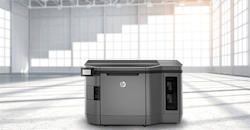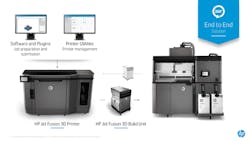HP dives into the 3D printing market with a system designed to produce parts up to 10 times faster and 50% cheaper than any other commercial system on the market today.
Over the last couple of years, it has become a common trope among 3D printer makers that their latest machine or material or deposition head or system innovation has somehow "reinvented" 3D printing.
Some of these claims come close to fulfilling that promise, but normally they are just over-hyped iterations of decades-old technologies—exciting iterations, sure, but not exactly reinventing anything.
This morning, however, HP unveiled a new machine that might just do it.
After two years of anticipation, HP finally pulled the curtain off its Jet Fusion 3D Printing Solution—a truly novel and fresh take at additive manufacturing designed for both prototyping and final part production.
This first entrance to the market from the computing and 2D printing giant—built in collaboration with a global network of partners ranging from Nike and BMW to Siemens and Autodesk—dismisses known and proven additive technologies to build strong parts, more durable parts, faster and cheaper than anyone in the market ever thought possible.
And that's by no small measure.
According to Alex Monino—head of marketing and go-to-market for HP's 3D printing business—the new machine could produce parts up to 10 times faster at about 50% of the cost of current commercial 3D printing systems.
HP's Jet Fusion technology uses a powder-based system similar to binder jetting or selective laser sintering (SLS) systems, but rather than gluing the plastic powder together or melting sections of it with lasers, it builds structures through a two-part system that transforms and then fuses the material, layer-by-layer, on the micron level.
"In one pass, we address the whole bed," Monino explained. "Because we have more time to actually fuse the material, the material is actually exposed to heat two orders of magnitude longer than SLS. This is a significant step in productivity."
This allows users to take extremely tight control over how each flake of powder behaves in the fused piece, meaning users can vary rigidity and strength through a solid build and, eventually, even conductivity.
"[The HP Jet Fusion 3D Printing System] will eventually print circuits as part of the part," Monino explained. "If you print an integrated circuit into a part with transforming agents with conductive properties, it will basically embed strain gauges and electronics into it so you can measure its performance in real time."
Eventually, he said, this will enable OEMs to connect every single part of their products into the Internet of Things."
Imagine the car or plane of the future where absolutely every plastic part that is in that system is actually reporting its status," he said. "Every part is potentially connected."
That may sound like science fiction, but it is exactly the kind of large-scale disruption HP is trying to stir with this technology.
"Our strategy is not to play in the $4-5 billion market of 3D today," Monino said. "We have a bigger vision, which is to drive the next industrial revolution. And that could unleash a potential market of up to $12 trillion dollars."
About the Author
Travis Hessman
VP of Content, Endeavor Business Media
Travis Hessman is the VP of Content for Endeavor Business Media. Previously, Travis was the Editor-in-Chief for Industry Week and New Equipment Digest as well as the Group Editorial Director for Endeavor's Manufacturing Group.
He began his career as an intern at IndustryWeek in 2001 and later served as IW's technology and innovation editor. Today, he combines his experience as an educator, a writer, and a journalist to help address some of the most significant challenges in the manufacturing industry, with a particular focus on leadership, training, and the technologies of smart manufacturing.



